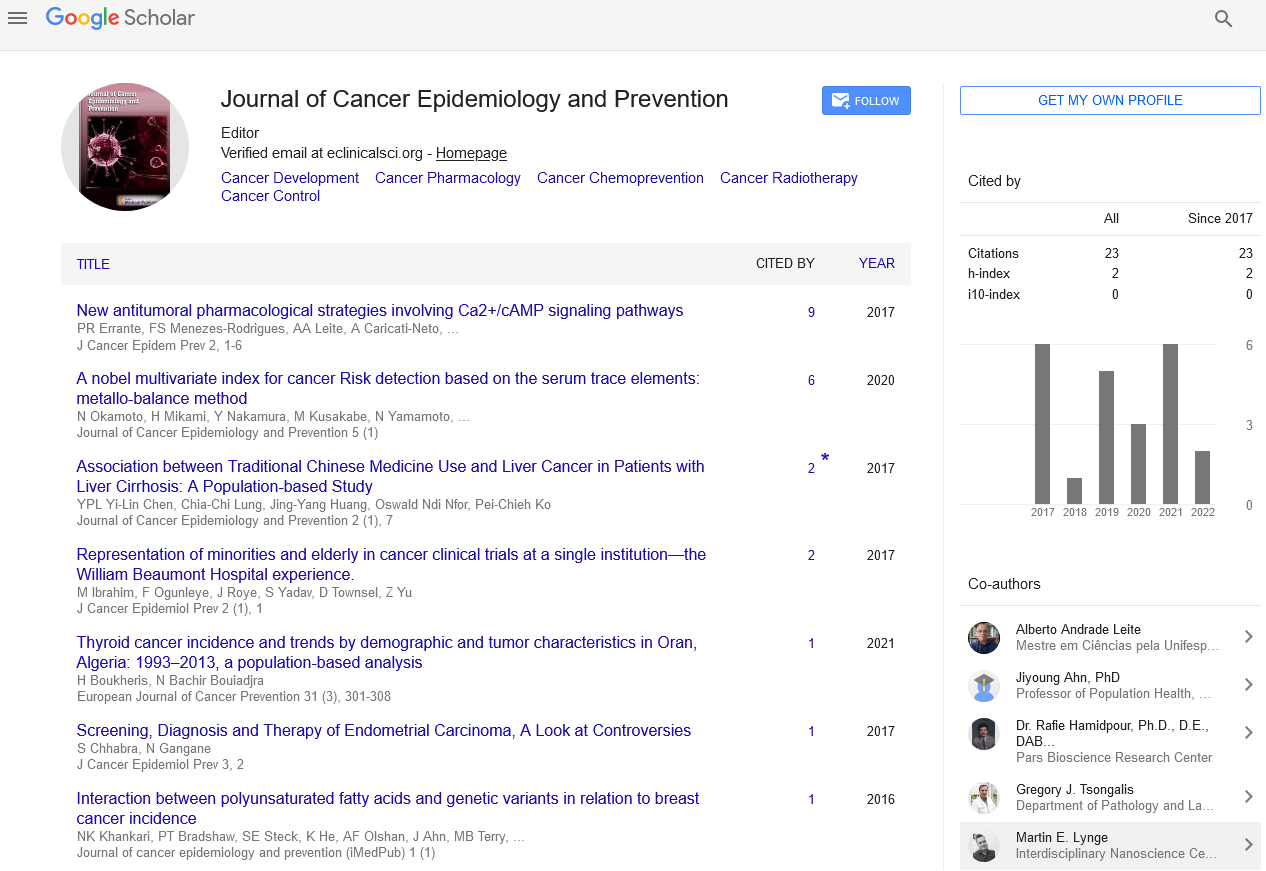Commentary - (2024) Volume 9, Issue 2
Advances in Cancer Screening: A Comprehensive Overview
Elizabeth Wilson*
Department of Medical Epidemiology, Karolinska Institute, Sweden
*Correspondence:
Elizabeth Wilson,
Department of Medical Epidemiology, Karolinska Institute,
Sweden,
Email:
Received: 29-May-2024, Manuscript No. IPJCEP-24-20846;
Editor assigned: 31-May-2024, Pre QC No. IPJCEP-24-20846 (PQ);
Reviewed: 14-Jun-2024, QC No. IPJCEP-24-20846;
Revised: 19-Jun-2024, Manuscript No. IPJCEP-24-20846 (R);
Published:
26-Jun-2024, DOI: 10.36648/IPJCEP.9.2.14
Description
Cancer remains one of the most formidable challenges in
modern medicine, affecting millions of lives worldwide each
year. Detecting cancer early is crucial for improving treatment
outcomes and survival rates. Cancer screening plays a pivotal
role in early detection by identifying abnormalities or cancerous
cells before symptoms manifest. Over the years, advancements
in technology and medical understanding have transformed
cancer screening techniques, making them more accurate,
accessible, and effective. This article explores the evolution,
current landscape, challenges, and future directions of
cancer screening. The concept of cancer screening dates back
several decades, evolving from basic physical examinations to
sophisticated technological approaches. Early methods, such
as palpation and visual inspection, were limited in their ability
to detect cancers in their early stages. The introduction of
screening programs for specific cancers, such as mammography
for breast cancer and Pap smears for cervical cancer,
revolutionized early detection efforts. These programs rely on
systematic screening of asymptomatic individuals within target
populations to identify pre-cancerous lesions or early-stage
cancers. The success of these programs in reducing mortality
rates underscores the importance of early detection in cancer
management. Despite being the gold standard, mammography
has limitations, particularly in dense breast tissue where
tumours can be obscured. Offers improved visualization of
breast tissue and reduces false positives compared to traditional
mammography. Direct visualization of the colon allows for the
detection and removal of precancerous polyps. Detects blood in
the stool, which can indicate the presence of colorectal cancer
or polyps. Detects abnormal cervical cells before they become
cancerous. Identifies high-risk Human Papillomavirus (HPV)
strains associated with cervical cancer. Measures levels of PSA in
the blood, which can indicate prostate abnormalities. Palpation
of the prostate gland for abnormalities. Recommended for
high-risk individuals, such as heavy smokers, to detect lung
nodules at an early stage. Recent years have witnessed rapid
advancements in technology, enhancing the accuracy, sensitivity,
and accessibility of cancer screening methods. Analyse blood
samples for circulating tumour cells or fragments of tumour
DNA, offering a non-invasive method for detecting cancer and
monitoring treatment response. AI algorithms analyse medical
imaging data (e.g., mammograms, CT scans) to detect subtle
abnormalities that may indicate cancer, improving diagnostic
accuracy. Identifies genetic mutations or biomarkers associated
with increased cancer risk, guiding personalized screening and
prevention strategies. Used for training healthcare professionals
in performing complex procedures, such as endoscopies and
biopsies, enhancing procedural accuracy and patient safety.
While cancer screening has made significant strides, several
challenges remain. Screening may detect slow-growing cancers
or benign abnormalities, leading to unnecessary treatment
and potential harm to patients. Socioeconomic factors,
geographic location, and healthcare infrastructure influence
access to screening programs and follow-up care, contributing
to disparities in cancer outcomes. Screening tests can yield
false-positive results (indicating cancer when none is present)
or false negatives (missing cancerous lesions), impacting
patient anxiety and delaying diagnosis. Balancing the benefits
of early detection with the potential harms of screening,
such as radiation exposure (in imaging tests) or psychological
distress, requires careful consideration. Combining genomic,
proteomic, and metabolomics data to develop comprehensive
biomarker panels for early cancer detection and personalized
risk assessment.
Acknowledgement
None.
Conflict Of Interest
The author’s declared that they have no conflict of interest.
Citation: Wilson E (2024) Advances in Cancer Screening: A Comprehensive Overview. J Cancer Epidemiol Prev. 9:14.
Copyright: © 2024 Wilson E. This is an open-access article distributed under the terms of the Creative Commons Attribution License, which permits unrestricted use, distribution, and reproduction in any medium, provided the original author and source are credited.

